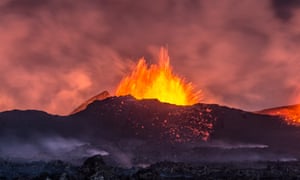| | | They always look for a way.
I went to Iceland this past year; it was beautiful. The locals told me of 'bitch' called Mount Katla as well as the the Vatnajokull glacier, which has receded several miles over the last 120 years. I jokingly asked them if it was from climate change, and they responded that the receding glacier is exposing Viking farms and tree stumps. Thus, the glacier wasn't there 1000 years ago, grew to the ocean for several hundred years, and is receding again. No big whoop, they say.
theguardian.com
Climate change is lifting Iceland – and it could mean more volcanic eruptions
Land moving upward faster than researchers expected at 1.4in every year, allowing ‘hot potato’ rocks to rise

A volcanic eruption seen from a distance on 12 September 2014 in Holuhraun, Iceland. Photograph: Einar Gudmann / Barcroft Media
Suzanne Goldenberg, US environment correspondent
Friday 30 January 2015 17.34 ESTLast modified on Friday 30 January 2015 17.39 EST
Iceland is rising because of climate change, with land freed by the melting of the ice caps rebounding from the Earth at a rate of up to 1.4in per year.
The downside? Researchers believe the extra uplift could be behind an increase in volcanic activity, with three Icelandic eruptions in the last five years shutting down flights and spewing ash in the air.
In new research published in Geophysical Research Letters, scientists from the University of Arizona and the University of Iceland found the earth’s crust rising at a much faster rate amid the greater warming of the last 30 years.
At some sites in south and south-central Iceland, where five of the largest ice caps are located, ice loss resulting from that warming produced an uplift of 1.4in per year, the researchers said.
Researchers have known for some time that land freed from the weight of ice sheets tends to rise. But they did not anticipate just how swiftly the bounce in Iceland was occurring.
“It’s similar to putting weights on a trampoline. If you take the weights off, the trampoline will bounce right back up to its original flat shape,” said Richard Bennett, a geologist at the University of Arizona and one of the authors of the new research.
The bigger bounce was due to increased warming over the last 30 years, mathematical models showed.
“What we found is that the uplift is increasing. It’s faster and faster everywhere because of the accelerated loss of ice mass,” said Bennett.
The researchers relied on 62 GPS devices, deployed on rocks throughout Iceland, to track the changes in position. Some of the GPS receivers had been in position since 1995.
The danger is that increased melting and uplift could lead to a further uptick in volcanic activity. Iceland has experienced three eruptions in the last five years. When Eyjafjallajökull blew in 2010, flights across Europe were disrupted for a week.
The entire chain reaction of melting ice caps, rising earth surface and volcanic activity is still not entirely understood, Bennett said. But as the surface of the earth rises, so do rocks at depth, released from the pressure of the ice.
“They transport the heat like a hot potato as they move from high pressure to lower pressure and enter into conditions that promote melting,” Bennett said. And that creates conditions that are ripe for eruptions. |
|





